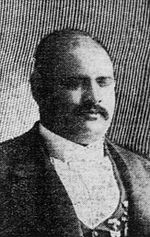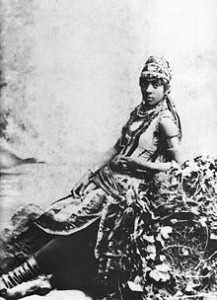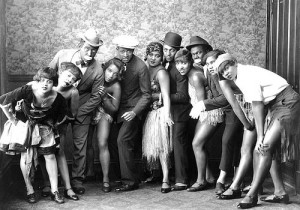
This week’s open thread topics has highlighted rarely spoken about or unknown black burlesque dancers and vaudeville performers. Today’s open thread will talk about various vaudeville performers.
Pat H. Chappelle (1869-1911) was a black showman who helped pave the way for African-American performers. He was able to learn the show business ropes from is uncle Julius C. Chappelle which allowed him to meet the soon to be famous Franklin Keith and Edward F. Albee producers of vaudeville. Pat ended up working for Keith and Albee as a piano player. During his vaudeville debut, he was able to meet Edward Elder Cooper who was a journalist interested in black entertainment. Cooper was the first to write a journal about the African-American race, 1891.
This later helped Chappelle get the news out about his theater after he established it. He did not buy a theater right off the bat, he bought a space and originally opened it to be a billiard and pool room. As business grew due to tourist Chappelle was able to turn the space into a saloon and concert hall called “Excelsior Concert Hall”. The theater was a success, famous performers known today appeared on his stage and his audience contained a variety of black and white patrons. Chappelle did not stop there, he went on to start his own touring company titles Imperial Colored Minstrels which changed to Famous Colored Minstrels. The show was primarily based on minstrelsy but it also contained various Vaudeville acts. After their southern tour ended, Pierce Hamilton and Chappelle opened The Buckingham Theater Saloon were the headliners would be The Famous Colored Minstrels. The performances were described as “The best Vaudeville show in Hillsborough County”.
In the Indianapolis Freeman, a journal started by Cooper, contained an advertisement that said “We employ none but professionals”. In March 1900, a reporter said “The house is crowded every night with Cubans, Spaniards, Negros, and white people.” A different reporter said, “These theaters have proven themselves to be miniature gold mines.” His next project was a touring show called A Rabbit’s Foot. The difference between this tour and previous ones were the cast was sixty people, and all performers would be comfortable. If a black performer was able to tour in a white circuit, they would not be allowed to sleep in the hotels when they stopped to rest, because the hotels would not allow it. They slept on the bus because it was better than the floor.
On Cappelle’s tour, the Freeman described their travel accommodations would be “their own train of new dining and sleeping cars, which ‘tis said, when finished, will be a ‘palace on wheels.” Like his Famous Imperial Minstrel players A Rabbit’s Foot contained minstrel and a variety of acts while maintaining the expected vaudeville staging flare. Chappelle offered a show for everyone.
The black musicians and composers of the vaudeville era influenced what is now known as American musical comedy, jazz and Broadway musical theater. The popular music of the time is ragtime, consisting of the piano and banjo. Ragtime was developed from black folk music. The tempo of Ragtime matched the pace of the Vaudevillian revue type show. Thomas Greene Bethune or “Blind Tom” a piano playing genius would have been recognized as child prodigy like Mozart if he was not born black. Tom has composed 100 pieces and could play over 7,000.
Thomas “Blind Tom” Wiggins (May 25, 1849 – June 14, 1908) was an African-American autistic savant and musical prodigy on the piano. He had numerous original compositions published and had a lengthy and largely successful performing career throughout the United States. During the 19th century, he was one of the best-known American performing pianists.
He was exploited by a slave owner John Benthune. For example, John let Tom perform to make himself money. “Blind Tom” made $100,000 in 1866 and only received $3,000 of this. John William Boone was a fellow blind pianist, a professional at the age of fourteen, known as “Blind Boone”. John and Tom shared a piano ragtime style of “jig piano”. This consisted of the left hand playing the beat of the juba while the right hand played the fiddle and banjo melodies. This music portrayed slaves dances, including beats created by the only instrument they were left with, their bodies.
 John William Boone was born in a Federal militia camp near Miami, Missouri, May 17, 1864, to a contraband slave, Rachel Carpenter, who had been owned by descendants of Daniel Boone. His father was a bugler in the 7th Missouri State Militia Cavalry (Union). Doctors removed both of Boone’s eyes when he was six months old in an attempt to cure his brain fever. He grew up in Warrensburg, Missouri, where Camp Grover was the headquarters of the 7th MSM at the end of the Civil War.
John William Boone was born in a Federal militia camp near Miami, Missouri, May 17, 1864, to a contraband slave, Rachel Carpenter, who had been owned by descendants of Daniel Boone. His father was a bugler in the 7th Missouri State Militia Cavalry (Union). Doctors removed both of Boone’s eyes when he was six months old in an attempt to cure his brain fever. He grew up in Warrensburg, Missouri, where Camp Grover was the headquarters of the 7th MSM at the end of the Civil War.
Boone had musical talent that was recognizable at a remarkably young age. Because of this, his hometown of Warrensburg decided to make sure that Boone received an education and paid for him to attend the St. Louis School for the Blind in 1872 to study piano. After growing bored with his experience there, Boone’s rule breaking habits got him expelled. He returned to Warrensburg where he began playing with local musicians.
The Hyers Sisters, Anna and Emma, were the first African-American women to perform on the Vaudeville stage; starting in 1876.  Their specialty was acting and singing. Later they ran a theater company for 30 years that contained a multitude of acts.
Their specialty was acting and singing. Later they ran a theater company for 30 years that contained a multitude of acts.
The Hyers Sisters, Anna Madah (ca. 1855 – 1929) and Emma Louise (ca. 1857 – 1901), were singers and pioneers of black musical theater. With Joseph Bradford and Pauline Hopkins, the Hyers Sisters produced the “first full-fledged musical plays… in which African Americans themselves comment on the plight of the slaves and the relief of Emancipation without the disguises of minstrel comedy.” Their first play was Out of Bondage (also known as Out of the Wilderness).
Their father, Samuel B. Hyers, came west to Sacramento, California with their mother, Annie E. Hyers (née Cryer), after the Gold Rush. He made sure his daughters received both piano lessons and vocal training with German professor Hugo Sank and later opera singer Josephine D’Ormy and they performed for private parties before making their professional stage debut at on April 22, 1867 at Sacramento’s Metropolitan Theater. Anna was a soprano and Emma a contralto. Under their father’s management, they embarked on their first transcontinental tour in 1871. On August 12, 1871, they performed in Salt Lake City to much acclaim.
They were later called “a rare musical treat” by Saint Joseph, Missouri’s Daily Herald and earned equal praise in Chicago, Cleveland, and New York City. Their tour reached Worcester and Springfield, Massachusetts, as well as New Haven and Providence. They visited Boston, which was known to be extremely critical of new acts, and were also well-received, performing in the 1872 World Peace Jubilee which was one of, if not, the first integrated major musical production in the country.
The Hyers’ family organized a theater company, where they produced musical dramas starring Anna and Emma, including Out of Bondage, written by Joseph Bradford and premiered in 1876, Urlina, the African Princess written by E. S. Getchell and premiered in 1879, The Underground Railway, by Pauline Hopkins in July 1880, and Hopkin’s stage version of Uncle Tom’s Cabin in March 1880. In addition, there was Colored Aristocracy by Hopkins. Overall, they had at least six shows between the late 1870’s and 1880s. They set the path for black musical theater and performance in the years that followed. They traveled until the mid-1880’s with their own shows and continued to appear on stage into the 1890’s. Though Emma Louise had died, in 1901, Anna Madah continued to travel with a show of John Isham.
African American Theater Studies scholar Nadine George-Graves writes The Whitman Sisters were the highest paying act in the Vaudeville circuit. The sister names were, Mabel, Essie, and Alberta. They were a singing and dancing act. The sisters started performing for their church. Later, the two older sisters were invited to perform in New York by George Walker but their father and manger said no so they stayed to finish their education. The sisters continued performing in the south. Eventually they were able to perform for King George V. The sisters started a company called The Whitman Sisters’ New Orleans Troubadours. They added other acts such as Bill “Bojangles” Robinson. People of all races enjoyed their show. Even after Vaudeville was no longer in its prime, they continued to perform in theaters and churches around the nation and were admired by all types of audience members.


